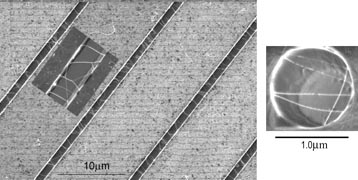Suspended Carbon Nanotubes as Mulecular Sensors
BACKGROUND: Relatively large surfaces areas and great sensitivity to environmental conditions make carbon nanotubes (CNTs) very promising candidates for sensing elements. However, all existing CNT sensing methods based on electronic or acoustic techniques require complicated nanotube architectures involving multiple fabrication steps. Such complexity can increase the probability of material defects, and often requires CNTs of very high purity. Such problems have blocked the commercialization of CNT sensor systems.DESCRIPTION: A scientist at the University of California, Merced (UC Merced) has invented a molecular sensing system based on the optical properties of CNTs. Starting with CNTs suspended on a thin film substrate (described in the publication listed below), one can process the suspended CNTs (shown in figure 1 below) according to this invention to render CNT optical properties highly sensitive to the presence of biomolecules or other molecules of interest.
APPLICATIONS: This invention is generally useful for molecular sensing applications, particularly sensors for biomolecules. Given the thin film substrate used in the UC Merced CNT sensor system, it could be easily integrated into devices such as labs-on-chips.
ADVANTAGES: UC Merced CNT molecular sensors:
* are ultrasensitive;
* can be integrated into labs-on-chips;
* use a simple architecture with facile manufacturability;
* are more tolerant of CNT synthesis imperfections; and
* can employ any type of CNT with a diameter <2.0 mm;
REFERENCE: 2007-620
FIGURE 1—Electron micrographs of the CNT suspension system described in J. Phys. Chem. B, 110:10585–10589. Subsequent processing of these CNTs sensitizes their optical properties to specific biomolecules.
Attached files:

Type of Offer: Licensing
« More Biotech Patents
